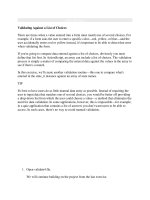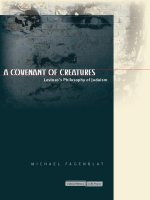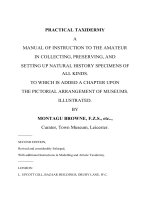Small Animal Dentistry A manual of techniques doc
Bạn đang xem bản rút gọn của tài liệu. Xem và tải ngay bản đầy đủ của tài liệu tại đây (11.2 MB, 290 trang )
Small Animal
Dentistry
A manual of techniques
Cedric Tutt
www.vet-dentist.com
Small Animal
Dentistry
A manual of techniques
Cedric Tutt
www.vet-dentist.com
© 2006 by Cedric Tutt
Blackwell Publishing editorial offices:
Blackwell Publishing Ltd, 9600 Garsington Road, Oxford OX4 2DQ, UK
Tel: +44 (0)1865 776868
Blackwell Publishing Professional, 2121 State Avenue, Ames, Iowa 50014-8300, USA
Tel: +1 515 292 0140
Blackwell Publishing Asia Pty Ltd, 550 Swanston Street, Carlton, Victoria 3053, Australia
Tel: +61 (0)3 8359 1011
The right of the Author to be identified as the Author of this Work has been asserted in
accordance with the Copyright, Designs and Patents Act 1988.
All rights reserved. No part of this publication may be reproduced, stored in a
retrieval system, or transmitted, in any form or by any means, electronic, mechanical,
photocopying, recording or otherwise, except as permitted by the UK Copyright,
Designs and Patents Act 1988, without the prior permission of the publisher.
First published 2006 by Blackwell Publishing Ltd
ISBN-13: 978-1-4051-2372-3
ISBN-10: 1-4051-2372-9
Library of Congress Cataloging-in-Publication Data
Tutt, Cedric.
Small animal dentistry / Cedric Tutt.
p. ; cm.
Includes bibliographical references and index.
ISBN-13: 978-1-4051-2372-3 (hardback : alk. paper)
ISBN-10: 1-4051-2372-9 (hardback : alk. paper)
1. Veterinary dentistry. 2. Dogs–Diseases–Treatment. 3. Cats –Diseases–
Treatment. I. Title.
[DNLM: 1. Dentistry–veterinary. SF 867 T967s 2006]
SF867.T88 2006
636.089′ 76–dc22
2006012268
A catalogue record for this title is available from the British Library
Set in 10.5/13 pt Sabon
by Graphicraft Limited, Hong Kong
Printed and bound in Odder, Denmark
by Narayana Press
The publisher’s policy is to use permanent paper from mills that operate a sustainable
forestry policy, and which has been manufactured from pulp processed using acid-free
and elementary chlorine-free practices. Furthermore, the publisher ensures that the text
paper and cover board used have met acceptable environmental accreditation standards.
For further information, visit our subject website: www.BlackwellVet.com
This book is dedicated to my parents Leslie and Rona Tutt who did not
spare anything in allowing us to develop into the people we are today,
and to my wife Kim whose love I cherish.
In reviewing dental embryology and development I have once again
come to realise the intricate way in which our bodies have been
constructed and reaffirm that there is a God who commands our belief
in Him.
v
Contents
Acknowledgements vi
Chapter 1 Tooth Development (Odontogenesis) 1
Chapter 2 Clinical Examination 33
Chapter 3 Equipping a Veterinary Dental Operatory 59
Chapter 4 Radiography 83
Chapter 5 Exodontics 131
Chapter 6 Jaw Fracture Repair 173
Chapter 7 Oral Surgery 185
Chapter 8 Suture Material 197
Chapter 9 Restoration 203
Chapter 10 Endodontic Therapy 213
Chapter 11 Pain Management 229
Chapter 12 Malocclusions and Normal Occlusion 239
Chapter 13 Cases to Refer to Your Local Veterinary Dentist 269
Index 275
v
Acknowledgements
I was introduced to veterinary dentistry as an undergraduate student by
Dr Frank Verstraete and was subsequently able to pursue this interest during
a seven year sojourn in the United Kingdom. During this time Drs Cecilia
Gorrel and Judith Deeprose were instrumental in broadening my ‘dentistry
horizons’ and they were a pleasure to work with. Veterinary dentistry is not a
procedure that can be performed in isolation by the veterinary surgeon and
I have had the privilege of working with a number of competent veterinary
nurses. Kelly Young and Sue Vranch were extremely helpful to me especially
during the early years when some procedures took longer than they do now!
Numerous members of the British Veterinary Dental Association and the
European Veterinary Dental Society and College have encouraged me through
the years and their help has been appreciated. My rough sketches and descrip-
tions have been converted into concise illustrations by Dr David Crossley,
whose help is acknowledged.
I would like to thank Antonia Seymour for initiating this project and for her
patience with its often delayed progress.
Kim, my wife, has helped me tirelessly. Her attention to detail kept me from
being verbose and thanks to her your navigation through this book using the
index will be a pleasure.
To the editorial and commissioning staff at Blackwell Publishing and their
copy editor, my sincere thanks for your help, encouragement and keeping the
project on track!
vivi
1 Tooth Development (Odontogenesis)
Dogs and cats have two sets of teeth, namely the primary or deciduous
dentition, and the secondary or permanent dentition. The primary dentition
develops during the embryonic and foetal stages, while the permanent
dentition develops during the foetal and neonatal stages of development.
Tooth development progresses through a number of stages.
Stages of tooth development
Initiation stage
Induction (an interaction between embryological tissues) is necessary for ini-
tiation to begin. The influence of mesenchymal tissues on ectodermal tissues
is known as induction.
The primitive oral cavity is lined by ectoderm, the outer portion of which
gives rise to the oral epithelium and is separated from the underlying
mesenchyme (influenced by neural crest cells) by the basement membrane.
The oral epithelium grows down into the mesenchyme giving rise to the
dental lamina.
Bud stage
The dental lamina proliferates into the mesenchyme forming buds from
which the teeth will develop. The mesenchyme also proliferates, still separated
from the dental lamina by the basement membrane. All teeth develop from
ectoderm and mesoderm which is influenced by neural crest cells.
Cap stage
Proliferation continues with differential growth of parts of the tooth bud
leading to a cap shape. The predominant process during this stage is morpho-
genesis which determines the eventual shape of the tooth. Deep within the
tooth bud the enamel organ develops, the inner layer of which will determine
the crown shape. The enamel organ, which is of ectodermal origin, will produce
enamel to cover the surface of the tooth crown. Within the confines of the cap
the mesenchymal tissue forms the dental papilla from which the dentine and
pulp will develop. The dental papilla remains separated from the enamel
organ by the basement membrane. The dentino-enamel junction (DEJ) will
develop in place of the basement membrane when it disintegrates. The mes-
enchyme surrounding the enamel organ forms the dental sac from which the
periodontium will develop. The periodontium is thus of mesenchymal origin.
The three structures present at the end of the cap stage, namely the enamel
organ, dental papilla and the dental sac, are collectively known as the tooth
germ.
Bell stage
Proliferation, morphogenesis and differentiation continue. The cells of the
enamel organ differentiate into four distinct layers:
(1) inner enamel (dental) epithelium which will differentiate into ameloblasts
and produce enamel;
Small Animal Dentistry
2
(2) stratum intermedium supporting enamel production;
(3) stellate reticulum supporting enamel production;
(4) outer enamel (dental) epithelium which protects the enamel organ during
amelogenesis. (Figure 1.1)
The enamel organ is still separated from the dental papilla by the basement
membrane.
Concurrently the dental papilla differentiates into two layers: the outermost
layer will differentiate into odontoblasts and produce dentine while the inner
layer will develop into the tooth pulp. The dental sac will differentiate into its
separate tissues (gingiva, alveolus, periodontal ligament and cementum) at a
later stage.
Apposition and maturation
During apposition, the matrices of enamel, dentine and cementum are laid
down which will be mineralised into the final structures during maturation.
The developmental process
During the bell stage the inner enamel epithelium differentiates into pre-
ameloblasts which induce the outer cells of the dental papilla to differentiate
into odontoblasts which in turn secrete pre-dentine on their side of the base-
ment membrane. At this stage the basement membrane separating the pre-
ameloblasts and odontoblasts disintegrates. Contact with pre-dentine induces
the pre-ameloblasts to develop into ameloblasts which begin amelogenesis,
secreting enamel matrix, via Tome’s process, onto the disintegrating base-
ment membrane. The DEJ is formed by mineralisation of the disintegrated
Figure 1.1 The tooth germ consists of the enamel organ, dental papilla and dental sac.
3
basement membrane. Secretion of both dental matrices continues as the
cells (odontoblasts and ameloblasts) retreat from the DEJ. The ameloblasts
lose contact with the DEJ, but the odontoblasts retain contact via the odonto-
blastic process within the dentinal tubule. Odontoblasts remain vital within
the pulp but ameloblasts are lost after tooth eruption.
Primary dentine is produced until apexogenesis (development of the tooth
root apex) is complete. Secondary dentine is laid down from completion of
apexogenesis throughout the life of the tooth. Under certain circumstances
when the tooth is damaged, the pulp will be stimulated to produce tertiary or
reparative dentine in an attempt to protect the pulp from exposure. Tertiary
dentine is less structured than secondary dentine and becomes stained leading
to black or brown spots usually in the centre of worn teeth surfaces. These dis-
coloured spots must be differentiated from exposed, impacted pulp chambers
and caries lesions.
The dentinal tubules are usually patent from the pulp to the dentino-enamel
junction (DEJ) and dentino-cemental junctions and house the odontoblastic
processes and sensory nerves. Exposed dentine can therefore cause severe pain
and must be treated.
Root development
Once the crown is fully formed and begins to erupt into the mouth root develop-
ment begins. The root is formed by the cervical loop which is the most apical
portion of the original enamel organ and is comprised of the two epithelial
layers (inner and outer enamel epithelium). The cervical loop grows down
into the dental sac enclosing more of the dental papilla forming Hertwig’s
root sheath. Hertwig’s root sheath determines the shape of the root/s and
induces production of root dentine. Root and crown dentine are continuous,
not separate, structures.
The inner enamel epithelial cell layer of Hertwig’s root sheath induces
the outer cells of the dental papilla to become odontoblasts which produce
pre-dentine in a similar manner to that formed in the crown. After formation
of root dentine, the basement membrane which has until now separated
Hertwig’s root sheath from the dental papilla, disintegrates along with
Hertwig’s root sheath. The remnants of Hertwig’s root sheath are called the
epithelial rests of Malassez which are located in the mature periodontal liga-
ment (Figure 1.2). When stimulated, these cells may develop into cysts and
require treatment. The root continues to develop until the apex is formed. The
apical delta has numerous ramifications through which the pulp communic-
ates with the periodontal ligament. Trauma to the immature tooth may cause
pulpitis followed by pulp necrosis which will interfere with apexogenesis and
may result in tooth death, requiring extraction. Damage to the developing
root may cause an angulation of the root known as dilaceration.
Cementum
Undifferentiated cells of the dental sac are exposed to the root dentine when
Hertwig’s root sheath and the basement membrane disintegrate, inducing
them to become cementoblasts. Cementoblasts secrete cementoid which con-
tains cementocytes (cementoblasts which become trapped in the cementoid).
Small Animal Dentistry
4
Cementoid undergoes mineralisation into cementum. Apposition of cementum
on root dentine forms the dentino-cemental junction.
In man the cemento-enamel junction presents in one of three arrangements:
(1) in 60% of teeth cementum overlaps enamel
(2) in 30% cementum and enamel abut
(3) in 10% there is a gap between cementum and enamel.
In (3), exposed dentine leads to dentinal hypersensitivity which is painful.
This can occur in some animals as well. Where dentine is exposed it should be
sealed with an unfilled resin, varnish or sealant.
Hypercementosis is the production of excessive cementum on the apical
third of the root. This can occur as a result of chronic inflammation and may
complicate extractions in cats (Figure 1.3).
Periodontal ligament
The periodontal ligament withstands rotational and other forces applied to
the tooth keeping it within the alveolus.
During crown and root development, mesenchyme from the surrounding
dental sac begins to form the periodontal ligament and the tooth alveolus.
Collagen fibres are formed which span the space between the cementum and
the alveolar bone supporting the tooth within the alveolus. The periodontal
ligament is made up of a number of fibre groups:
Tooth Development (Odontogenesis)
Figure 1.2 The root begins to develop
when the tooth erupts into the mouth.
5
(1) the alveolar crest group, which span the alveolar margin and the coronal
part of the root, and which resist tilting, intrusion, extrusion and rota-
tional forces;
(2) the horizontal group of fibres which span the coronal part of the root
and the alveolus, which keep the tooth in a vertical position resisting tilt-
ing and rotational forces;
(3) the oblique group of fibres oriented margino-apically from the alveolus
to the root surface preventing intrusion of the root and resisting rota-
tional forces;
(4) the apical group which span apico-marginally from the alveolus on to
the root, preventing extrusion of the root and resisting rotational forces.
In multi-rooted teeth inter-radicular (trans-furcation) fibres resist extru-
sion, intrusion, tilting and rotational forces (Figure 1.4).
What happens when things go wrong during tooth
development?
Initiation stage
Anodontia (absence of teeth) or partial anodontia (hypodontia) results from
failure of initiation. Supernumerary teeth are formed during initiation and
may cause crowding (Figure 1.5). When crowding causes compromise of the
normal teeth the supernumerary teeth should be extracted (Figure 1.6). Some
breeds have developmental anomalies which result in abnormalities with the
dentition. Most Chinese crested dogs have numerous missing teeth. This is an
inherited condition rather than an idiopathic lack of initiation (Figure 1.7).
Small Animal Dentistry
Figure 1.3 Dog mandibular right
premolars affected by hypercementosis.
Note the lack of periodontal ligament
space.
6
Bud stage
Macrodontia (abnormally large teeth) or microdontia (peg teeth) may occur.
Cap stage
Dens in dente. The enamel organ invaginates into itself, causing a tooth-like
structure to develop within the tooth. This is rare in animals. This condition
Tooth Development (Odontogenesis)
Figure 1.4 The periodontal ligament
fibres keep the tooth in the alveolus and
withstand: intrusive, extrusive, tipping
and rotational forces.
Figure 1.5 Supernumerary
mandibular right premolar 1 (405)
in a dog. The tooth can be kept in
this case as surrounding teeth are
not compromised.
7
may be under diagnosed in animals due to infrequent use of radiography in
veterinary dentistry.
Gemination is the complete or partial split of a single tooth bud resulting
in a mirror-image crown, i.e. two crowns which are mirror images of each
other (Figure 1.8). This gives the impression of an extra tooth in the affected
Small Animal Dentistry
Figure 1.6 Supernumerary mandibular
left 4th premolar in a cat. The
supernumerary tooth has exacerbated
periodontal disease affecting
surrounding teeth, necessitating
extraction.
Figure 1.7 Hypodontia (partial
anodontia) in a Chinese crested dog.
8
quadrant and is most commonly seen in dog incisors (Figure 1.9). The root
may also be partially or completely split (Figure 1.10).
Fusion is the union of two adjacent tooth buds resulting in one large tooth.
The affected quadrant will have one less tooth (Figure 1.11).
Additional cusps (tubercles) are sometimes seen in man and in Spaniels.
Tooth Development (Odontogenesis)
Figure 1.8 Gemination of mandibular
right 4th premolar in a cat. The tooth
bud has attempted to split to form
two teeth.
Figure 1.9 Gemination of maxillary
right incisor 2. There are four incisor
crowns visible in the maxillary right
quadrant.
9
Apposition and maturation
Enamel dysplasia. Enamel hypoplasia is a reduction in the quantity of enamel
produced leading to pitting and grooves on the teeth, while enamel hypo-
mineralisation results in reduced quality of enamel leading to discoloured teeth.
Small Animal Dentistry
Figure 1.10 Radiograph of case in
Figure 1.9 showing almost complete
separation of the roots in this divided
tooth.
Figure 1.11 Fused maxillary left
incisors 1 and 2 resulting in a large
tooth and one less incisor in the
maxillary left arcade.
10
Figure 1.13 Enamel hypoplasia in a
dog suffering from Distemper Virus
infection. Note that the mandibular
right deciduous canine and permanent
premolar 1 are not affected. This is
because these teeth were formed
prior to the infection.
Dentine dysplasia may also occur. These conditions are often seen in
dogs which have suffered from Distemper Virus infection and those which
have suffered bouts of pyrexia during amelogenesis and dentinogenesis
(Figures 1.12–1.15). The Distemper Virus can damage ameloblasts and
Tooth Development (Odontogenesis)
Figure 1.12 Malformed teeth in
a dog suffering from Distemper Virus
infection. Enamel hypoplasia is also
present.
11
odontoblasts and often results in abnormally shaped roots which undergo
premature completion of apexogenesis (Figures 1.16–1.17).
Iatrogenic damage to the tooth before about four months of age can present
as discolouration or enamel defects in the permanent dentition if care is
Small Animal Dentistry
Figure 1.14 Enamel hypoplasia and
dysplasia in a dog suffering from
Distemper Virus infection. Note the
severity of periodontal disease affecting
some incisors. This is as a result of
plaque accumulation on these teeth.
Figure 1.15 Enamel hypoplasia and
dysplasia in a dog suffering from
Distemper Virus infection. Note the
unaffected persistent mandibular left
deciduous canine.
12
Figure 1.17 Radiograph of the rostral
mandibles of a dog suffering from
Distemper Virus infection. Note that
the permanent canines are retained
(unerupted) due to premature
completion of apexogenesis. These
teeth may need to be extracted. Note
also the persistent mandibular right
deciduous canine.
not exercised during the extraction of deciduous teeth (Figure 1.18).
Fractured deciduous canines with exposed pulps leading to periapical patho-
logy can also cause enamel defects on the developing permanent teeth
(Figure 1.19).
Tooth Development (Odontogenesis)
Figure 1.16 Radiograph of maxillary
left canine (204) root in a dog suffering
from Distemper Virus infection. Note
the conical shape of the short roots.
Premature completion of apexogenesis
has occurred.
13
Tooth type and shape
Dogs and cats have three incisors and one canine in each quadrant. The
incisors are named: central, middle and lateral or numbered first, second
and third.
Small Animal Dentistry
Figure 1.18 Extreme care must be
exercised when extracting persistent
deciduous canine teeth, especially
when this is performed for interceptive
orthodontic purposes. Note the enamel
defects on this tooth (404) due to
iatrogenic damage during extraction of
the mandibular right deciduous canine
when this dog was ten weeks old. (Note
the brachygnathic mandibles.)
Figure 1.19 Fractured deciduous teeth
must be treated or periapical pathology
may result in damage to the adjacent
developing permanent teeth.
14
Using the modified Triadan system the quadrants are numbered from 1–4,
beginning with the right maxilla and ending with the right mandible in a
clockwise direction as viewed from the front of the animal. Using this system,
the maxillary right incisors are numbered 101, 102 and 103. Canines are
suffixed by 4 (104, 204, 304 and 404) and first molars by 9 (109, 209,
309 and 409). The primary dentition is numbered in the same way, with the
quadrant prefixes being 5, 6, 7 and 8 (e.g. maxillary right deciduous canine is
504 and mandibular right deciduous canine is 804 (Figure 1.20)). Figures 1.21
and 1.22 are radiographs showing mixed dentition in young dogs. Note the
thin dentine walls and ‘absence’ of roots in the permanent dentitions.
In dogs with a full complement of permanent teeth the dental formula is:
giving a total of 42 adult teeth.
Dog deciduous dentition formula is:
giving a total of 28 adult teeth.
Figure 1.23 shows the mandibular right deciduous incisors 2 and 3, canine
and premolars 2–4 in a young dog. Figure 1.24 shows the permanent
mandibular right incisors 1 and 2 and the deciduous lateral incisor, canine and
premolars 2 and 3 in a young dog. The dentition here is termed ‘mixed denti-
tion’ as deciduous and permanent teeth are present.
In cats with a full complement of permanent teeth the dental formula is:
giving a total of 30 adult teeth.
2 ×
I3 C PM3 M1
I3 C PM2 M1
2 ×
Id3 Cd PMd3
Id3 Cd PMd3
2 ×
I3 C PM4 M2
I3 C PM4 M3
Tooth Development (Odontogenesis)
Figure 1.20 The maxillary right
deciduous canine is numbered 504 and
the mandibular right deciduous canine
804 using the modified Triadan system.
15
Small Animal Dentistry
Figure 1.21 Radiograph of rostral
mandibles of a young dog with
developing permanent teeth.
Figure 1.22 Radiograph of rostral
mandibles of a young dog that has
linguo-verted mandibular deciduous
canines. Note how crowded the
permanent incisors are and how
close the permanent canines are
to each other.
16
Tooth Development (Odontogenesis)
Figure 1.23 Deciduous dentition in the
right mandible of a young dog. Middle
and lateral incisors, canine and
premolars 2–4 are visible.
Figure 1.24 Mixed dentition in a young
dog. The permanent first and second
incisors have erupted. The lateral
deciduous incisor, canine and
premolars 2 and 3 are still to be shed.
17









